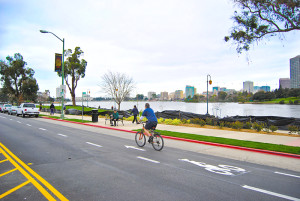Oakland Plans to Improve Bicyclist Safety

Oakland ranks the 13th safest city to ride a bicycle, according to the Alliance for Walking and Biking.
The city is working to make the streets of Oakland pedestrian-friendly. As of 2009, 87 miles of bikeways existed throughout the city. With a $204,000 Federal stimulus grant from the U.S. Department of Energy, more bikeway signage and markings are being installed along certain streets throughout the city.
“The overall trend is that the number of bicyclists is increasing dramatically—by 250 percent since 2000—while the total number of bicycle-involved collisions is relatively stable,” explains Jason Patton, Bicycle and Pedestrian Program Manager. “From 2000 to 2009, there was an average of 0.9 bicycle fatalities and 134 bicycle injuries per year,” Patton continued.
Reports were not filed in 2000 and 2001 for non-injury collisions, according to Oakland Master Bike Plan.
In 2007, there were 123 injury and fatality collisions, making the number of collisions 31 per 100,000 people according to the city of Oakland’s Bicycle Master Plan. However, this number does not account for number of collisions relative to the number of cyclists.
With an increase in cyclists comes a city that is more aware of cyclists on the streets. Patton calls this relationship “safety in numbers” and explains that it “is supported by research showing that the cities with the greatest number of bicyclists are the safest cities to ride in.”
The city of Oakland is currently working on increasing the number of bikeways. On busy streets, ‘Bike Lanes’ are designated.
“Designated bikeways improve safety by building awareness among drivers to expect cyclists on those streets,” the Engineering and Construction department of the city of Oakland states.
Bike Lanes are designated by signage, wide curb lanes, and ‘shallows’—stencils on the street that give the cyclist an idea of where is the safest place to ride is, and to avoid traffic as well as sudden opening doors from parked cars. Bike lanes must be at least 5 feet wide, with parallel parking places present, and 4 feet wide throughout. Oakland, however, is attempting to increase that space to 6 feet for cyclists, leaving 8 to 9 foot parking spaces to reduce injury from opening doors.
According to a report by the California Highway Patrol, approximately 60 percent of all collisions involving vehicles and bicycles put the cyclist at fault, the majority of the reason being riding on the wrong side of the road, or failing to obey traffic signs and signals. Approximately 40 percent of the time the driver is at fault; the most common reasons include improper turning, unsafe speed, and failure to obey traffic signs and signals.














